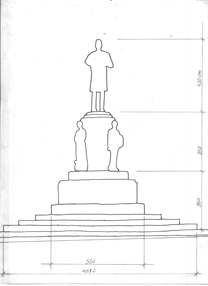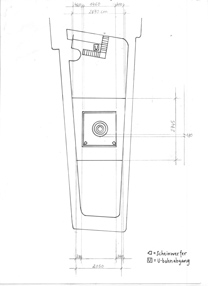
Karl Lueger statue
Skizze: Mona Liska

Karl Lueger
Skizze: Mona Liska
JOSEF MÜLLNER
Sculptor Josef Müllner was born in Baden and from 1896 to 1902 studied at the Vienna Academy of Fine Arts under Edmund von Hellmer and Karl von Zumbusch. From 1906 to 1911 he was a member of the Secession and in 1912 shifted to the Künstlerhaus. In the period from 1910 to 1948 he was a professor at the Academy of Fine Arts and was rector there from 1926 to 1928.
Müllner worked in a neo-classical style and his extensive oeuvre, which included very different subjects (reliefs, portrait busts, war memorials etc.), corresponds to the representational needs of a monarchy in decline. In his allegorical works, personifications and monuments he was a proponent of a sculptural approach that idealized and exhibited tendencies to eclecticism and classicism. It was thus able to remain essentially unmodified from the beginning of the century on into the Nazi period.
Many of his commissions were publicly placed and, at the time, found great approval. Between 1899 and 1949 Müllner received 23 major awards amongst which were the freedom of the cities of Vienna and Baden.
After being suspended because of the war, teaching at the academy restarted on the 23rd of April 1945 with 94 students amongst whom were members of the allied forces. On the 27th of June the first committee meeting of teaching staff took place. Only professors Boeckel, Müllner, Pauser and Pirchan were present and, interestingly enough, were not involved in the de-Nazification programme that was just getting underway.
Nowadays, because of his support for National Socialism in the years 1938 to 1945, Müllner and his work are very contested. Personally he never denied his “German conscious” position, to which he remained true through all the political changes. His was given honorary membership in the “Athenaia” student association which he retained till, as an old man, the association was disbanded.
One saying from his own lips was “you can’t do much in the visual arts by talking. The work has to talk, not the mouth.” (from: “Der akademische Bildhauer Josef Müllner (1879–1968)” by Walter Perko, 2nd edition edited by Rudolf Maurer, catalogue card entry no. 16, Rollett Museum, Baden).
The work with the title “Head of the Fallen Siegfried” (War Memorial) was very contested and in the 1990s provoked considerable debate. The memorial was erected by the German student’s association and their teachers in 1923. Josef Müllner was not only the work’s creator, but was also a member of the Artistic Commission of the Academic Senate of the University of Vienna. (from the book “Der Siegfried-Kopf” by Ulrike Davy and Thomas Vasek, WUV Universitätsverlag)
One of the statues to Karl Lueger is also by Müllner. It was made from a 1913 design and finally erected in Vienna’s first district in 1926.
In 1940 he made a bronze Hitler bust which stood in the assembly hall of the Vienna Academy. It was commissioned by the Reich governor and carried out, as he said, “with reluctance”. (from: “Der akademische Bildhauer Josef Müllner (1879–1968)” by Walter Perko, 2nd edition edited by Rudolf Maurer, catalogue card entry no. 16, Rollett Museum, Baden).
One expert opinion reported that he was not only a “refined character, a quiet, considered man, a fine artist” but also that he “had not carried out any Nazi propaganda”, was “always reserved” and “frequently spoke out against the Nazi regime in the sharpest possible manner”.
Josef Müllner Straße in Baden is called after him. He died of a heart attack at the age of 73 on the 3rd of January 1969 and is buried in Vienna’s central cemetery.